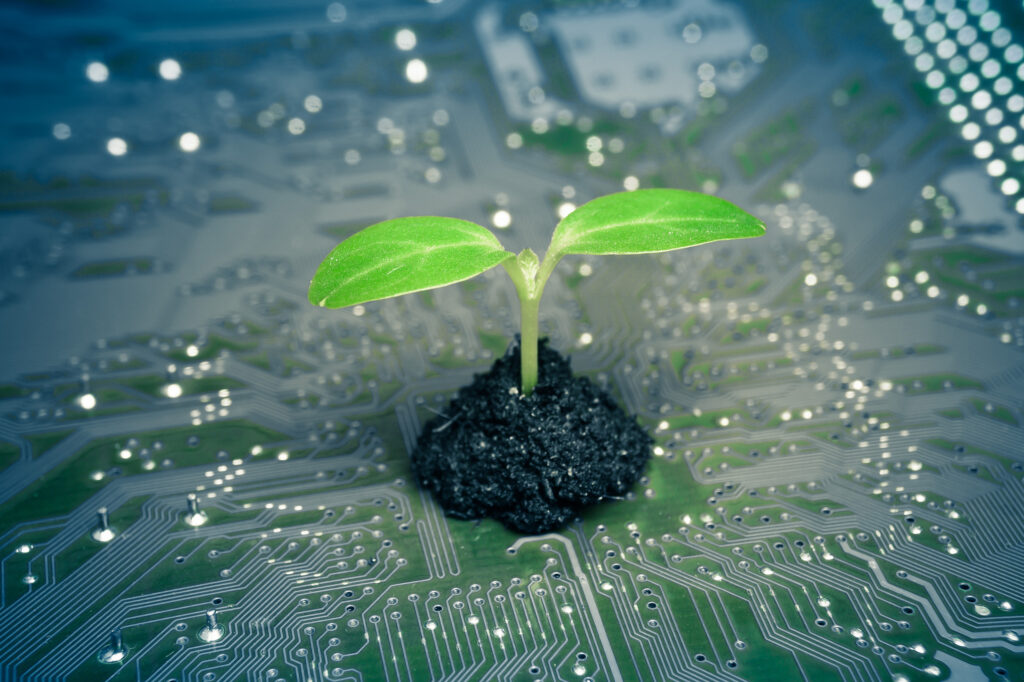The Green Future of IT

As the workforce moves out of the office and computer applications become more advanced, companies will continue to look for sustainable and cost-efficient ways to operate resources
Sustainable IT trends are on the rise, and companies should take notice of the potential cost savings and environmental benefits of greener practices.
By definition, Green IT practices suggest the use of information technology in a manner that preserves resources and protects the environment. It can involve everyday employee practices such as working remotely and holding video conferencing, to using cloud software services and virtualization of printing processes, to the general ways that companies maintain IT infrastructure such as server farms.
Ideally, Green IT practices will result in a reduction in energy consumption and the emission of pollution in the manufacture, use and disposal of products. In the long run, maintaining sustainable IT practices can also save a lot of money.
From a financial standpoint, the green IT services market has much to offer, as the market is projected to grow by about 11% CAGR by 2025 to become a $19 billion market, according to a report from Mordor Intelligence. That growth will be fed mostly by growing pressure on companies not only to reduce costs and optimize resources, but also from a consumer base interested in seeing industry cut their carbon footprint and do something better for the world they operate in.
Servers as electricity
Imagine being able to turn the huge amounts of heat generated by computer server systems into something useful.
“Waste heat is the scourge of computing; in fact, much of the cost of powering a computer is from creating unwanted heat,” according to a 2019 blog from Network World. “That’s because the inefficiencies in electronic circuits, caused by resistance in the materials, generates that heat. The processors, without computing anything, are essentially converting expensively produced electrical energy into waste energy.”
Researchers at Rice University are experimenting with a system that could turn heat from data centers into light, and then back into electricity.
If it works on a large scale, reusing heat that comes out of servers could be recycled into energy that, rather than being wasted, would be put to good use. And if you think that your computer sitting their on your desk doesn’t waste any energy, consider that it’s estimated the production of computer hardware such as PC monitors or towers consumes almost as much energy as their use over three to four years, according to a blog from SoftwareONE.
“The data center heat, instead of simply disgorging into the atmosphere to be gotten rid of with dubious eco-effects, could actually run more machines,” according to Network World. “Plus, your cooling costs would be taken care of—there’s nothing to cool because you’ve already grabbed the hot air.”
Less reliance on physical infrastructure
Remote workforces have been gaining popularity with the advent of the gig economy for a few years now. But if there’s anything the COVID-19 outbreak of 2020 has taught anyone, it’s the necessity of being able to keep your workforce going wherever employees consider work. From employees suddenly finding themselves needing to work from home virtually, or managers calling team meetings using software such as Zoom, remote means of work is now part of the fabric.
As it turns out, remote work is also a much greener way of doing things, and companies have an opportunity to turn the new work reality into savings. As a result, companies will begin relying more on cloud computing technology, and reduce their physical infrastructure such as servers and desktop computers, according to a 2019 blog from Blue & Green Tomorrow.
Some 81% of the energy a computer requires is expended when it’s being built, according to a blog from BMC, and they can waste a lot of power when sitting idle at empty workstations. What’s more, traditional desktop workstations are becoming obsolete. By replacing servers with cloud-based systems, employees can access files and information anywhere with an internet connection using tablets and smartphones. Many companies are also turning to remote printing services, which cuts down on the need for printers and other hardware, while also reducing paper waste and maintenance costs.
Moving to colder climates
For companies that need to maintain large server infrastructure, as is the case with cloud computing companies such as Google or Facebook, the challenge becomes finding a cost-efficient way to keep that complex machinery cool.
Many of these companies have found that cost savings and lower emissions could be as simple as putting on a winter coat. Apple, for instance, moved their server farms to Yerington, Nevada, while Facebook went to Sweden, and Google took over an old paper mill in Finland, where the colder air and water of these areas helps cool their server infrastructure.
Data centers are already large energy users, up to 30 billions watts of electricity, according to a report from Telehouse. By relocating to cooler areas, IT companies can cut energy cost dramatically by taking advantage of free air cooling systems and cutting down on their carbon footprint.
The IT needs of companies will become more widespread, especially as their interactions with customers become increasingly virtual. In addition, employees will spend more time working remotely and companies will need to continue to step up to meet the needs of both. If planned right, they can use sustainable practices to save money and help save the planet at the same time.